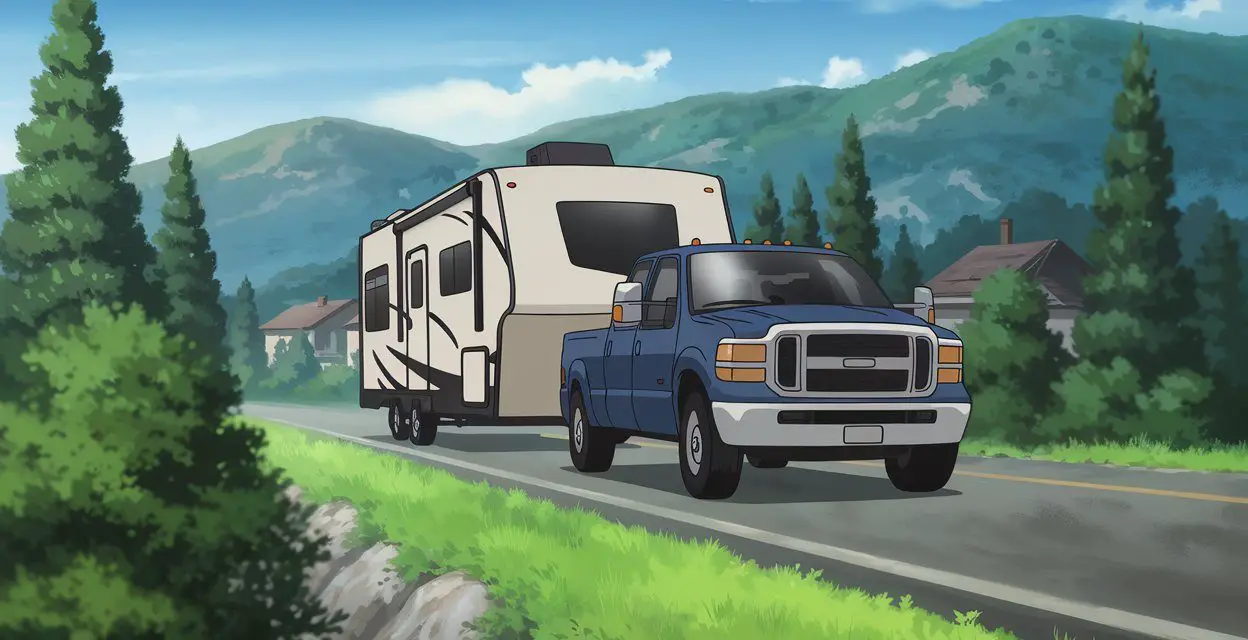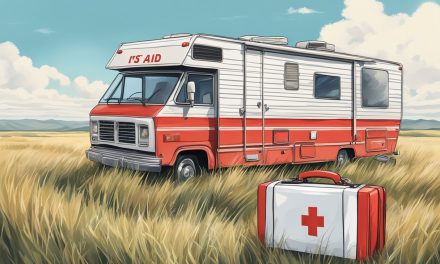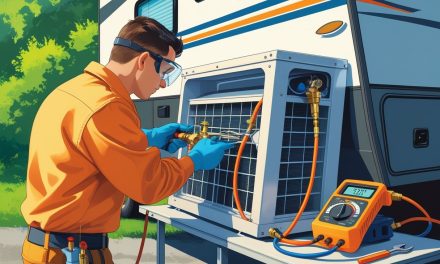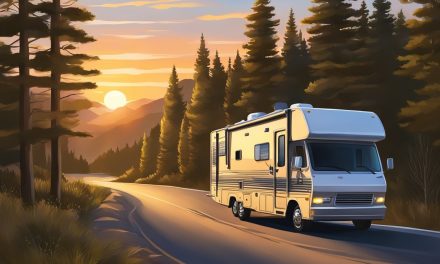Would you like to save this article?
Getting ready for your next big RV adventure but wondering if your Class C can handle towing your car? You’re not alone in asking this question! Class C RVs are like the perfect middle ground between big motorhomes and smaller campers. They’re big enough to live in comfortably but small enough that you might wonder if they can pull extra weight. The good news is that most Class C RVs can indeed tow a car, but there are some important things you need to know first. Think of it like asking if your friend can carry your backpack – sure they probably can, but you better make sure it’s not stuffed with rocks! In this guide, we’ll walk through everything you need to know about Class C towing, from weight limits to the best cars to tow behind your rig.
1. Understanding Class C RV Towing Capacity
Most Class C RVs can tow between 3,500 to 8,000 pounds, with many newer models hitting that sweet spot of 5,000 to 7,500 pounds. The exact amount depends on your RV’s chassis – think of the chassis as the “skeleton” of your RV that everything else is built on. Ford E-450 chassis typically offer the highest towing capacity at around 7,500 pounds, while smaller chassis like the Ford Transit might only handle 3,500 pounds. Your RV’s manufacturer will have a sticker somewhere (usually near the driver’s door) that tells you exactly how much your specific RV can tow. Don’t guess on this number – it’s like the speed limit, but for safety instead of tickets!
Class C Towing Capacity by Chassis:
| Chassis Type | Engine | Towing Capacity | Common RV Brands |
|---|---|---|---|
| Ford E-450 | 7.3L V8 | 7,500 lbs | Jayco, Forest River, Thor |
| Ford E-350 | 6.8L V10 | 5,000-6,000 lbs | Winnebago, Coachmen |
| Ford Transit | 3.5L V6 | 3,500 lbs | Winnebago Navion, Leisure Unity |
| Mercedes Sprinter | 3.0L V6 | 5,000 lbs | Winnebago View, Coachmen Galleria |
| Ram ProMaster | 3.6L V6 | 3,500 lbs | Forest River Sunseeker MBS |
Weight Breakdown:
- Towing Capacity: 3,500 – 8,000 lbs (average 5,000-7,500 lbs)
- Tongue Weight: Usually 10-15% of trailer weight
- Most Common Capacity: 5,000 lbs (covers 80% of Class C RVs)
Fun fact: The reason Class C RVs can tow more than you might think is because they’re built on truck chassis, not car frames. It’s like having a pickup truck dressed up as a house!
2. Best Cars To Tow Behind Your Class C
Not all cars are created equal when it comes to being towed behind an RV. The best “toad” (that’s RV slang for “towed vehicle”) is usually a small SUV or car that can be flat-towed with all four wheels on the ground. Popular choices include the Jeep Wrangler (around 4,400 pounds), Honda CR-V (about 3,300 pounds), and Chevy Equinox (roughly 3,500 pounds). You want something light enough to stay within your weight limits but practical enough to drive around once you’re at your destination. Manual transmissions are often easier to flat-tow than automatics, but many modern cars have “tow mode” settings that make this possible.
Top Flat-Towable Vehicles:
| Vehicle | Weight (lbs) | Transmission | Tow Rating | Best Features |
|---|---|---|---|---|
| Jeep Wrangler | 4,400 | Manual/Auto | Excellent | Off-road capability |
| Honda CR-V | 3,300 | CVT | Good | Great fuel economy |
| Chevrolet Equinox | 3,500 | Auto | Good | Roomy interior |
| Ford Escape | 3,200 | Auto | Fair | Compact size |
| Subaru Forester | 3,600 | CVT | Good | All-wheel drive |
| Nissan Versa | 2,600 | Manual/CVT | Excellent | Lightest option |
Here’s the funny thing about RV folks – they’ll spend hours debating which car to tow, but then forget to check if their favorite restaurant has RV parking!
3. Three Ways To Tow Your Car
You’ve got three main options for getting your car from Point A to Point B behind your Class C. Flat towing (also called “four-down” towing) means all four wheels stay on the ground – it’s like your car is just along for the ride. Dolly towing puts the front wheels on a little trailer while the back wheels roll on the road. Trailer towing means your whole car rides on a trailer, kind of like a piggyback ride. Each method has its pros and cons, and the best choice depends on your car, your budget, and how often you plan to tow.
Towing Methods Comparison:
| Method | Cost Range | Setup Time | Car Restrictions | Pros | Cons |
|---|---|---|---|---|---|
| Flat Tow | $2,000-4,000 | 5-10 minutes | Must be towable | Fastest setup, no storage | Car must be compatible |
| Dolly | $1,200-2,500 | 15-20 minutes | Front-wheel drive preferred | Works with most cars | Backing up impossible |
| Trailer | $3,000-6,000 | 20-30 minutes | Any car works | Universal compatibility | Expensive, storage needed |
The irony of RV life: You buy a house on wheels to simplify your life, then spend weeks figuring out how to bring your other car along too!
4. Essential Towing Equipment You’ll Need
Getting set up for towing isn’t as simple as tying a rope to your bumper (please don’t try that!). For flat towing, you’ll need a tow bar, base plates that bolt to your car’s frame, safety chains, and a supplemental braking system. The supplemental brakes are super important – they help your car stop itself when you’re slowing down your RV. You’ll also need wiring for turn signals and brake lights, plus a few smaller items like a breakaway switch. The whole setup can cost anywhere from $2,000 to $4,000, but it’s worth it for the convenience and safety.
Essential Equipment & Costs:
| Equipment | Price Range | Function | Installation Time |
|---|---|---|---|
| Tow Bar | $300-800 | Connects RV to car | 30 minutes |
| Base Plates | $400-600 | Bolts to car frame | 2-4 hours |
| Safety Chains | $50-100 | Backup connection | 15 minutes |
| Supplemental Braking System | $1,000-1,500 | Helps car brake | 3-5 hours |
| Wiring Kit | $100-200 | Lights and signals | 1-2 hours |
| Breakaway Switch | $50-100 | Emergency brake | 30 minutes |
RV dealers love selling towing equipment almost as much as RVers love buying it. It’s like collecting Pokemon cards, but each card costs a few hundred dollars!
5. Weight Distribution And Safety Tips
Here’s where things get a bit more technical, but don’t worry – it’s not rocket science! Your Class C has something called GCWR (Gross Combined Weight Rating), which is the maximum your RV plus everything you’re towing can weigh together. You also need to think about tongue weight – that’s how much downward pressure your towed car puts on your RV’s hitch. Too much tongue weight and your RV’s front end might lift up like it’s trying to do a wheelie. Too little and your whole setup might start swaying like a fish’s tail. Most cars should have a tongue weight of about 10-15% of their total weight.
Weight Distribution Guidelines:
| Weight Factor | Recommended Range | Why It Matters | What Happens If Wrong |
|---|---|---|---|
| GCWR | Never exceed rating | Legal/safety limit | Brake failure, fines |
| Tongue Weight | 10-15% of towed weight | Proper balance | Swaying, poor handling |
| Hitch Rating | Match or exceed tongue weight | Load capacity | Hitch failure |
| Tire Pressure | Check monthly | Heat dissipation | Blowouts, poor mileage |
| Load Distribution | 60% front, 40% rear in towed car | Stability | Fishtailing |
The physics of towing is like balancing on a seesaw while someone throws you bowling balls. Get the weight wrong, and things get interesting real quick!
6. Legal Requirements And State Regulations
Before you hit the road with your new setup, make sure you’re legal in all the states you’ll be traveling through. Some states require supplemental braking systems on towed vehicles over a certain weight (usually 3,000 pounds). Others have specific rules about safety chains, lighting, or licensing. A few states even require special endorsements on your driver’s license for certain combinations. The good news is that most states recognize each other’s requirements, but it’s worth checking the rules for your specific route. Nobody wants to get pulled over and find out they’re missing some required equipment!
State Towing Requirements:
| Requirement | States Requiring | Weight Limit | Typical Penalty | Notes |
|---|---|---|---|---|
| Supplemental Brakes | 15 states | 3,000+ lbs | $200-500 fine | Required: CA, OR, WA, etc. |
| Breakaway Switch | 45 states | All weights | $100-300 fine | Must be functional |
| Safety Chains | All 50 states | All weights | $150-400 fine | Proper rating required |
| Working Lights | All 50 states | All weights | $100-250 fine | Brake, turn, running lights |
| Special License | 8 states | Varies by combo | License suspension | Check before travel |
State towing laws are like RV park wifi – they exist, they’re supposedly important, but nobody’s quite sure how they actually work until you need them!
7. Cost Breakdown: What You’ll Really Spend
Let’s talk money because your wallet is probably already feeling nervous. The initial setup for flat towing typically runs $2,000 to $4,000 for equipment, plus installation costs if you’re not handy with tools. You might spend another $500 to $1,000 on miscellaneous items like hitch covers, storage bags, and “just in case” spare parts. Don’t forget about ongoing costs like additional insurance coverage (usually pretty cheap), maintenance on your towing equipment, and the extra fuel your RV will use pulling that extra weight. Most RVers find that the convenience of having their car available is worth every penny.
Complete Cost Analysis:
| Expense Category | Initial Cost | Annual Cost | 5-Year Total |
|---|---|---|---|
| Essential Equipment | $2,000-4,000 | $0 | $2,000-4,000 |
| Professional Installation | $500-1,000 | $0 | $500-1,000 |
| Accessories & Extras | $300-500 | $50-100 | $550-1,000 |
| Insurance Addition | $0 | $50-150 | $250-750 |
| Equipment Maintenance | $0 | $100-300 | $500-1,500 |
| Extra Fuel Costs | $0 | $200-600 | $1,000-3,000 |
| TOTALS | $2,800-5,500 | $400-1,200 | $4,800-11,250 |
RV towing is like having kids – the initial investment seems reasonable until you start adding up all the little extras. Before you know it, you’ve spent more on towing gear than you did on your first car!
8. Common Mistakes To Avoid
Even experienced RVers make mistakes when they first start towing, so don’t feel bad if you mess something up. The biggest mistake is not checking your weight ratings and trying to tow something too heavy – this can be dangerous and expensive if something breaks. Another common error is forgetting to disconnect your car’s battery or put it in the right gear before towing (this can fry your car’s electronics or transmission). Many people also underestimate how much longer it takes to stop, park, and maneuver when you’re pulling a car. Finally, don’t forget that your total length is now much longer – you’ll need to plan for bigger parking spaces and wider turns.
Common Towing Mistakes & Solutions:
| Mistake | Consequence | Prevention | Cost to Fix |
|---|---|---|---|
| Exceeding weight limits | Brake failure, accidents | Check all ratings first | $500-5,000+ |
| Wrong tow mode setup | Transmission damage | Read owner’s manual thoroughly | $2,000-8,000 |
| Skipping brake controller | Poor stopping power | Install proper controller | $100-300 |
| Inadequate mirrors | Blind spots, accidents | Add extended mirrors | $50-200 |
| Poor weight distribution | Swaying, instability | Adjust hitch properly | $200-500 |
| No pre-trip inspection | Equipment failure on road | 10-minute safety check | Prevention = Free |
| Forgetting disconnects | Electrical/mechanical damage | Use checklist every time | $500-3,000 |
The learning curve for RV towing is like learning to dance – you’ll step on a few toes (or curbs) before you get the hang of it, but eventually, you’ll be waltzing through truck stops like a pro!
Sources:
- Camping World RV Towing Guide
- Good Sam Community Forums
- eTrailer Towing Equipment Specifications
- RVIA Safety Guidelines
- iRV2 Forums Towing Section
- Thor Industries Towing Guide





